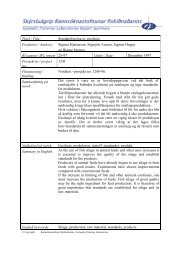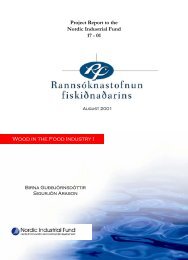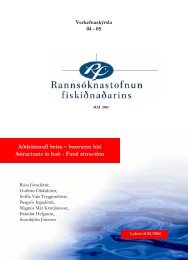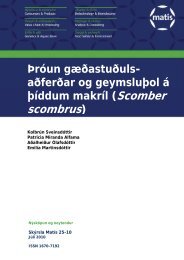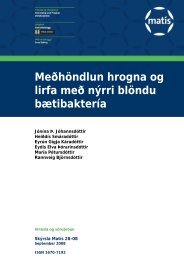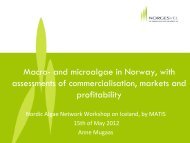Microbiology and Spoilage Trail in Nile Perch (Lates niloticus), Lake ...
Microbiology and Spoilage Trail in Nile Perch (Lates niloticus), Lake ...
Microbiology and Spoilage Trail in Nile Perch (Lates niloticus), Lake ...
You also want an ePaper? Increase the reach of your titles
YUMPU automatically turns print PDFs into web optimized ePapers that Google loves.
contam<strong>in</strong>ation by human, animal or birds along Mwanza gulf fish<strong>in</strong>g area. The presence of<br />
these <strong>in</strong>dicators organisms <strong>and</strong> pathogens <strong>in</strong> sediments implies contam<strong>in</strong>ation from faeces<br />
of human or animal orig<strong>in</strong>, (Huss, Dalgaard <strong>and</strong> Gram, 1997; Doyle, 1990).<br />
5.1.3 Phase I trial 3: Whole <strong>Nile</strong> perch<br />
The presence of Salmonella may <strong>in</strong>dicate contam<strong>in</strong>ation by aquatic birds or from animal<br />
orig<strong>in</strong>. Salmonella contam<strong>in</strong>ation of Whole <strong>Nile</strong> perch <strong>and</strong> <strong>Nile</strong> perch products can also<br />
result from fish h<strong>and</strong>lers <strong>and</strong> contact surfaces if GMP/GHP/HACCP programmes are not<br />
properly adhered too. The results of this study show significant Total Viable Counts <strong>and</strong><br />
Enterobacteriaceae counts <strong>in</strong> <strong>Nile</strong> perch guts samples. The Total Viable Counts range from<br />
2.4 x 10 2 – 1.0 x 10 6 cfu/g <strong>and</strong> the Enterobacteriaceae counts from 0 – 3.8 x 10 4 cfu/g.<br />
Both TVC <strong>and</strong> Enterobacteriaceae are <strong>in</strong> agreement with the range of 10 3 -10 6 cfu/g of guts<br />
found by Adams <strong>and</strong> Moss (2008); Shewan (1962); ICMSF (1980b); <strong>and</strong> Liston et al.,<br />
(1976). Suspicious presence of Vibrio cholerae bacterium <strong>in</strong> one sample of <strong>Nile</strong> perch guts<br />
may be attributed to the feed<strong>in</strong>g habit of fish which is carnivorous. It could have been<br />
feed<strong>in</strong>g on other small pelagic fishes like sard<strong>in</strong>es or small tilapias prior it was caught.<br />
5.2 PHASE II: SHELF LIFE OF LABORATORY ICED WHOLE NILE PERCH<br />
59<br />
AND CHILLED FILLETS<br />
5.2.1 Phase II trial 1: Shelf life of iced whole <strong>Nile</strong> perch<br />
5.2.1.1 Sensory/organoleptic assessment<br />
The storage time of whole <strong>Nile</strong> perch was estimated 3- 4 weeks i.e. 26-28 days. The<br />
excellent <strong>and</strong> very good freshness quality fish scored < 10 <strong>and</strong> 10-12 total QIM scores<br />
respectively. This was <strong>in</strong> agreement to the ma<strong>in</strong> goal of QIM that enables processors to<br />
predict the rema<strong>in</strong><strong>in</strong>g storage time of fish stored <strong>in</strong> ice (Larsen et al. 1992, Nielsen <strong>and</strong><br />
Jessen 1997, Hydilg <strong>and</strong> Nielsen 1998, Mart<strong>in</strong>sdottir et al. 2001). When the QIM score<br />
equals to 10 the rema<strong>in</strong><strong>in</strong>g storage time <strong>in</strong> ice is estimated to be about 5 days (Huss, 1995).<br />
In this study, total QIM score was 10 when whole <strong>Nile</strong> perch storage time <strong>in</strong> ice was




